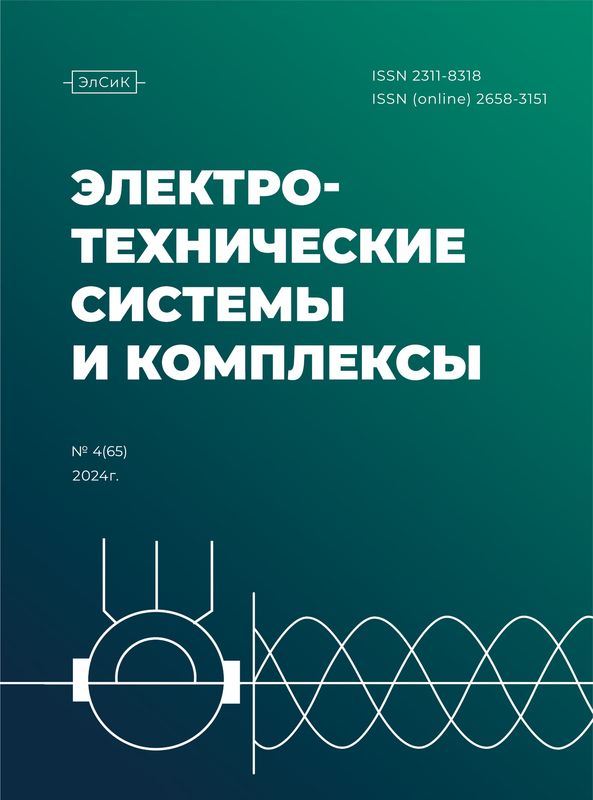Abstract
The paper is concerned with the calculation of parameters for the squirrel-cage induction motor using a pre-trained neural network. The relevance of this work lies in the potential use of the neural network as a tool for the accurate T-equivalent circuit parameters identification during motor fault diagnostics or its initial commissioning. The aim of the study is to evaluate the parameter identification accuracy for its subsequent use as a diagnostic tool. The methods employed include machine learning (neural networks), electrical machine and electric drive theory, mathematical modeling of transient processes and experiments (no-load test and locked-rotor test) conducted on a test bench. The neural network training was based on the data from 4A series induction motors with a power range from 90 W to 200 kW. The developed approach, utilizing a trained neural network, is tailored to specific motor types and enables the equivalent circuit parameters identification for subsequent analysis and diagnostics. The paper describes the parameter identification process using the neural network, detailing its structure, input and output data and tuning parameters. A methodology for verifying the identified parameters adequacy through mathematical modeling of transient processes was developed. The identification accuracy is assessed on a real-world Siemens induction motor (which was not included in the training dataset). The optimal neural network configuration in terms of the neurons number in the hidden layer was selected. Conclusions were drawn regarding the accuracy and applicability of the neural network as a tool for identifying equivalent circuit parameters.
Keywords
squirrel-cage induction motor, equivalent circuit, motor parameters, neural network, parameter identification
1. Konokhov D.V. Energoeffektivnoe pryamoe upravlenie mo-mentom asinhronnyh tyagovyh elektrodvigatelej. Kand.Diss. [Energy-efficient direct torque control of asynchronous trac-tion motors. Kand. Diss.]. Bryansk, 2018. 138 p.
2. State Standard 11828-86. Rotating electric machines. General test methods. Moscow, Publishing House of Standards, 2003. 32 p. (In Russian)
3. Masandilov L.B., Kuraev N.M. T-equivalent circuit applica-tion for calculating static characteristics and analyzing squir-rel-cage induction motor energy modes. Vestnik Moskovskogo energeticheskogo instituta [Bulletin of MPEI], 2018, no. 2, pp. 80-86. (In Russian) doi: 10.24160/1993-6982-2018-2-80-86
4. Bunkov D.S. Review of methods for estimating the asyn-chronous electric machine equivalent circuit parameters for organizing a vector control system. Elektrotekhnicheskie i in-formacionnye kompleksy i sistemy [Electrical and data pro-cessing facilities and systems], 2021, no. 3-4. (In Russian) doi:10.17122/199-5458-2021-17-3-24-38
5. Eremochkin S. Yu., Dorokhov D. V., Zhukov A. A. Choos-ing a reliable method for calculating the asynchronous motor equivalent circuit parameters. Vestnik NGIEI [Bulletin of NGIEI], 2022, no. 12 (139). (In Russian) doi: 10/244412/2227-9407-2022-12-43-53
6. Mugalimov R.G., Khramshin R.Ya., Mugalimova A.R. Comparative analysis of methods for calculating the asyn-chronous motors electrical equivalent parameters. El-ektrotekhnika: setevoj elektronnyj nauchnyj zhurnal [Russian Internet Journal of Electrical Engineering], 2016, vol. 3, no. 1, pp. 36-40. (In Russian)
7. Sivokobylenko V.F., Tkachenko S.N., Derkachev S.V. Cal-culation of equivalent circuits parameters and asynchronous motor characteristics. Elektrichestvo [Elektrichestvo], 2014, no. 10, pp. 38-44. (In Russian)
8. Terekhin A.A., Dadenkov D.A. Review of methods for iden-tifying asynchronous electric drive parameters]. Vestnik Permskogo natsionalnogo issledovatelskogo politekhnich-eskogo universiteta. Elektrotekhnika, informacionnye tekhnologii, sistemy upravleniya [PNRPU Bulletin. Electro-technics, Informational Technologies, Control Systems], 2017, no. 22, pp. 55-66. (In Russian)
9. Chernyshov K.N. Comparative analysis of methods for online identification of asynchronous motor parameters. In-formatsionnye sistemy i tekhnologii 2015 : Materialy III Mezhdunarodnoj nauchno-tekhnicheskoj internet-konferencii, Orel, 01 aprelya – 31 2015 goda. [Proceedings of the III International scientific and technical Internet conference "Information systems and technologies 2015"]. Orel, Sterkh Publ., 2015, pp. 8. (In Russian)
10. Omelchenko E.Ya., Lymar A.B. Identification of asynchro-nous motors equivalent circuit parameters using neural net-works. Elektrotekhnicheskie i informacionnye kompleksy i sistemy [Electrical and data processing facilities and systems], 2023, vol. 19, no. 4, pp. 31-44. (In Russian) doi: 10.17122/1999-5458-2023-19-4-31-44
11. Diwan R.D. Induction Motor Testing Using MATLAB/Simulink. International Research Journal of En-gineering and Technology (IRJET). 2021, no. 8(6), pp. 1810-1815.
12. Bentounsi A., Djeghloud H., Benalla H., Birem T., Amiar H. Computer-Aided Teaching Using MATLAB/Simulink for Enhancing an IM Course With Laboratory Tests. IEEE Transactions on Education. 2011, no. 54(3), pp. 479-491. doi: 10.1109/TE.2010.2085046
13. Kucuk S., Ajder A. Analytical voltage drop calculations during direct on line motor starting: Solutions for industrial plants. Ain Shams Engineering Journal. 2022, no. 13(4), 101671. doi: 10.1016/j.asej.2021.101671
14. Shin H.-J., Cho M.-Y., Chun H.-I., Kim J.-S. A Study on the Tolerance Band of Voltage Drop during Motor Startup for Refineries and Chemical Plants with Isolated Power Systems. Journal of Electrical Engineering and Technology. 2017, no. 12(1), pp. 486-493. doi: 10.5370/JEET.2017.12.1.486
15. Makarov V.G. Motor parameter and rotor currents identifica-tion for a three-phase asynchronous motor. Elektrotekhnich-eskie sistemy i kompleksy [Electrotechnical systems and complexes], 2010, no. 18, pp. 173. (In Russian)
Lymar A.B., Omelchenko E.Ya., Bochkarev A.A. Calcu-lation of Equivalent Circuit Parameters for a Squirrel-Cage Induction Motor on a Test Bench Using a Neural Network. Elektrotekhnicheskie sistemy i kompleksy [Elec-trotechnical Systems and Complexes], 2025, no. 3(68), pp. 29-34. (In Russian). https://doi.org/10.18503/2311-8318-2025-3(68)-29-34










